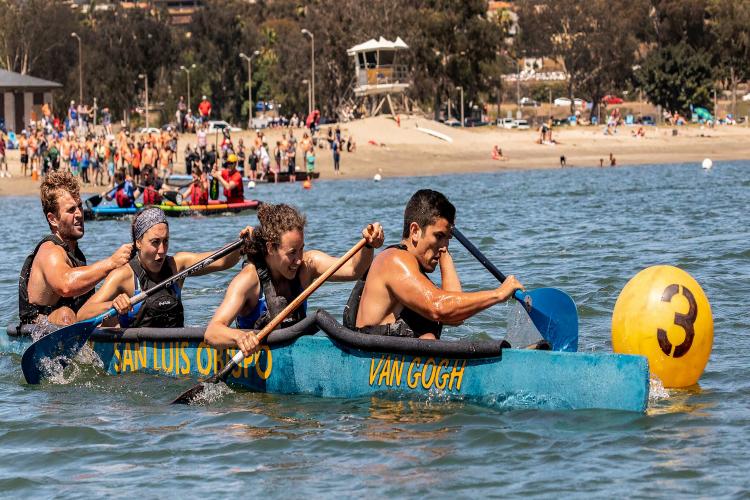Peering out the barred windows of his asylum bedroom, Vincent van Gogh found inspiration in the night sky.
While he believed “The Starry Night” was a failure, more 130 years later, his iconic oil painting has ingrained itself in popular culture with nods in movies, books, music and at least one concrete canoe.
Cal Poly’s concrete canoe team recently won its 5th national championship – with a canoe that channels the famed post-impressionist painter. A work of art itself, the canoe is rich with colors, offering a nod to “The Starry Night” and other van Gogh classics.
“We have some good artists on the team,” said Brandon Friedman, the team’s project manager and a civil engineering major from Porter Ranch, CA. “And there was never a shortage of what we were going to do for art. Because van Gogh had so much inspiring stuff. ‘Sunflowers’ and ‘Starry Night.’ ‘Irises.’ It was kind of like, ’How are we going to bring it to life?’”
Prior to the team competing at the nationals in San Diego, we talked to Friedman about van Gogh and the art of building concrete canoes.

Hailey Bond and Brandon Friedman (right) prepare their canoe for competition. Friedman, the team’s project manager, said Cal Poly’s success is due in part to the passing of information from past champs.
I’m gonna start with one that probably everyone asks you: Why don’t concrete canoes sink?
It’s the principle of displacement. You create enough buoyant force so that you’re able to, within the material itself, be able to use different lightweight rocks . . . so that the unit weight of the concrete is less than the unit weight of the water. So when that happens it’s able to float. So our unit weight ended up being around 53, and the unit weight of water is 62.4.
How did you improve on last year’s?
You used to be able to make a base color, and all the aesthetics were painted on the bottom. Now everything has to be pigmented concrete. You can’t paint, but you can put colors in the concrete and cast those colors side by side. So we really tried to get a lot of different colors in there. We have like 15 different colors, whereas last year’s canoe had two.
So you think this one stands out from the others because of that?
Aesthetically? Definitely. She’s a beaut.
Jacky Loh helps prepare Cal Poly’s canoe for competition.
Jacky Loh helps prepare Cal Poly’s canoe for competition. The Cal Poly team has won five national championships.
This is beneficial for you guys because . . . why?
It’s hands-on experience. You’re learning about concrete mixtures and properties. . .We’re constantly talking to industry and making those connections. We can interact with them and say, “Teach us a little bit about what you do in the process.” It’s something we don’t get out of reading our textbooks.
What’s the difference when you paddle this as opposed to your typical canoe you rent?
This one’s definitely heavier. It goes a little bit slower.
How did the idea for the van Gogh theme come about?
We all put our ideas on a document and sat down and hashed them out and see which ones were reasonable. Van Gogh seemed like a cool thing because you could take different paths with it, and you have so many beautiful pieces of artwork.
What were some of the rejected ideas?
There’s always a big push for an aquatic-type theme. I think the other really close one this year was a magician – like an old-school magician theme. We had a lot of cool ideas for what we’d do, but what held us back was the actual color of it. We couldn’t figure out what colors would make it pop out.
Why is Cal Poly so successful at this?
Knowledge transfer. There’s never a year where a team comes in with a blank slate. All the alumni are willing to help, and we have a huge database of what we’ve done before, which really helps us because we’re not making the same mistakes they made before.
What do you do with all the old ones?
There are more and more canoes coming in. We have two first place canoes sitting next to the shed right now. So we’re telling next year’s group to reach out to companies and sell to them. We’ve sold canoes before for three to five grand. The other option is to get like a multi-canoe holding rack and put one on top of the other and keep them displayed in a consolidated area.


